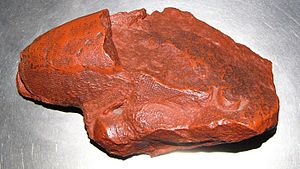Arandaspis
| Arandaspis | ||||||||||||
|---|---|---|---|---|---|---|---|---|---|---|---|---|

Reconstruction of Arandaspis |
||||||||||||
| Temporal occurrence | ||||||||||||
| Lower Darriwilium to Upper Darriwlium | ||||||||||||
| 466 to 461 million years | ||||||||||||
| Locations | ||||||||||||
| Systematics | ||||||||||||
|
||||||||||||
| Scientific name | ||||||||||||
| Arandaspis | ||||||||||||
| Ritchie and Gilbert-Tomlinson , 1977 |
Arandaspis is an extinct genus of the pteraspidomorphi belonging to the family of Arandaspididae . This primitive jawless fish ( Agnatha ) lived in the Lower Ordovician in Australia .
etymology
The term Arandaspis ( Shield of Aranda ) is a neologism from the living at the site Aborigenenstamm of Aranda and the Greek word ἀσπίς aspis (plate) composed.
Initial description
Arandasis was first scientifically described in 1977 by Alexander Ritchie and Joyce Gilbert-Tomlinson. A more recent revision was made by Jack Sepkoski (published posthumously in 2002).
Taxonomy
Robert L. Carroll (1988), the genus Arandaspis in named after her family Arandaspididae , along with the controversial taxon Anatolepis and Porophoraspis . Sacambaspis is another possible sister taxon. The only previously known subtaxon is next to Arandaspis sp. Young 1997 Arandaspis prionotolepis Ritchie & Gilbert-Tomlinson 1977.
features
Arandaspis was about six inches long. The bones of an inner skeleton are not present, but the inner and outer impressions of its bony, flat outer armor have been preserved in fossil form. The front part of the body and the head region were protected by stiffened plates with openings for the eyes. Nostrils, pineal opening and the inner ear were missing. Behind the frontal outer armor, its streamlined body was covered by small, lined, humped armor scales.
The outer armor, which is just 0.1 millimeters thick, can be used to distinguish between a back plate and a stomach plate 6 to 7 centimeters long. The roof-shaped back plate ran towards a somewhat reinforced ridge; their edges sat on the steep branchial plates on the side, which protected the gills below . The belly plate adjoining it was rounded downwards and gave the animal an overall oval cross-section. Both the back and abdominal plates had grooved recesses running longitudinally, probably for nerve tracts and lateral line organs . Up to 15 rectangular branchial plates were present, which marked the position of the gill pockets. It appears that they did not open to the outside, and that the gills communicated with the outside world through a pair of openings behind the plates, as is the case with better-known relatives from the Silurian . The plates show no signs of growth or fusions of several small plates, so they could only have formed after they had reached their full size. Their outsides are ornamented with small rhombic cusp scales , similar to Anatolepis . With the exception of the gill pockets, the insides of the bone plates do not reveal any body structures. The bone plates were thus completely independent of the rest of the body and had a purely protective function.
The animal had no fins , so its locomotion was dependent on the laterally flattened tail fin . His swimming style should not have been dissimilar to a modern tadpole .
Way of life
Arandaspis probably lived as a filter feeder in the open sea. Ritchie and Gilbert-Tomlinson (1977) are of the opinion, however, that Arandaspis resided immediately above the sea floor and fed on organic debris and microorganisms that were brought in by currents .
Occurrence
The type fossil was discovered in 1959 in the Stairway Sandstone near Alice Springs in the Northern Territory . So far, Arandaspis finds have been made in the following formations :
- Rowena Formation , Mutawintji National Park , New South Wales ( Darriwilium )
- Stairway Sandstone Formation (Darriwilium)
Individual evidence
- ^ A b Alexander Ritchie and Joyce Gilbert-Tomlinson: First Ordovician vertebrates from the Southern Hemisphere . In: Alcheringa . tape 1 , 1977, pp. 351-368 .
- ^ Joseph John Sepkoski: A compendium of fossil marine animal genera . In: Bulletins of American Paleontology . tape 363 , 2002, p. 1-560 .
- ^ A b Robert Lynn Carroll : Vertebrate Paleontology and Evolution . WH Freeman and Company, New York 1988, ISBN 0-7167-1822-7 .
- ^ Palmer, D .: The Marshall Illustrated Encyclopedia of Dinosaurs and Prehistoric Animals . Marshall Editions, London 1999, ISBN 1-84028-152-9 , pp. 23 .
- ^ Gavin C. Young: An Ordovician vertebrate from western New South Wales, with comments on Cambro-Ordovician vertebrate distribution patterns . In: Alcheringa . tape 33 , 2009, p. 79-89 .
- ^ Gavin C. Young: Ordovician Microvertebrate Remains from the Amadeus Basin, Central Australia . In: Journal of Vertebrate Paleontology . tape 17 (1) , 1997, pp. 1-25 .


